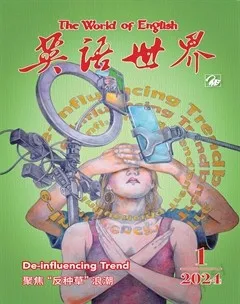Is De-influencing Another Form of Influencing?“反种草”是另一种“种草”吗?
阿底提·迈耶/文 冯懿/译
These days, it’s hard to escape the clutches of influencer culture that in many ways defines our digital landscape. Over on TikTok, there are even now tutorials on how to become an influencer.
如今,人们很难摆脱网红文化的控制。这种文化在诸多方面定义了我们的数字化景观。现在TikTok上甚至还有关于如何成为网红的教程。
Recently though, there has been a tide shift, thanks to the rise of the new “de-influencing” trend. It’s a response to overconsumption propagated by influencers, and growing cynicism towards sponsored content (#sponcon) on social media.
最近,由于“反种草”新浪潮兴起,潮流发生了转变。这股浪潮回击了网红们宣扬的过度消费,也呼应了针对社交媒体上的赞助内容(#sponcon)日益高漲的质疑声。
Going through the de-influencing hashtag now, you’ll see two prominent camps of content: on one hand, the trend has evolved from discouraging consumption to recommending one product over another instead. And while encouraging people to buy less and buy better is a step in the right direction, the critique remains that this sort of content dampens the true goal of the de-influencing movement.
现在浏览“反种草”话题标签,你可以看到两个明显的内容阵营:一方阵营认为,这股浪潮已经从劝退消费演变为推荐购买某种产品而非另一种产品。虽然鼓励人们买得少、买得好是朝正确方向迈出的一步,但仍有批评声称,这类内容有碍“反种草”运动实现真正的目标。
Cue the second camp of content: individuals reflecting on the ways that social media has skewed our view of what normal consumption habits look like—a refreshing reminder on a platform where copious consumption often reigns supreme.
另一方阵营的个体则在反思社交媒体如何扭曲了大众对什么是正常消费习惯的理解——在过量消费时常占主导地位的TikTok上,这真是个让人眼前一亮的提醒。
As a 26-year-old—on the cusp1 between being a millennial and Gen Z—my relationship with the internet began at a time that predates today’s prolific creator economy. I came of age2 online in many ways, watching the evolution of social media platforms from being a space where you share your life with your IRL3 friends to becoming a hugely commodified platform that’s laced with ad space.
我生于千禧一代向Z世代过渡的时期,今年已26岁。我与互联网的渊源始于如今这种多产的创作者经济出现之前。从很多方面来说,我是在互联网上长大的,从小目睹社交媒体平台的演变,眼看着它从与现实中的朋友分享日常生活的地方,变成充斥着广告位的大型商品化平台。
The overconsumption of fashion on the internet—which has normalised buying clothes just for an Instagram post—prompted my own journey as a sustainable fashion blogger. I wanted to subvert the idea of the fashion influencer by focusing on wider issues covering social and environmental justice in fashion. Since then, an entire wave of sustainability content creators has emerged, challenging the traditional idea of the influencer, who has often fed an aspirational image rooted in unsustainability. From this perspective, the practice of de-influencing is far from new. However, the popularity of the current hashtag means it has now transcended sustainability circles, permeating internet discourse at large.
互联网上过度的时装消费,让仅为在Instagram上发帖而购买衣服成为常态,也促使我踏上成为可持续时尚博主之路。我想关注涉及面更广的议题,包括时尚界的社会公正和环境正义,以此来颠覆人们对时尚界网红的印象。后来,一大批可持续内容创作者涌现出来,向传统的网红形象发起挑战,后者展示的積极形象常常建立在社会不可持续的发展上。从这个角度看,“反种草”的做法绝不新鲜。然而,“反种草”话题标签的热度之高,意味着这股浪潮现在已经超出可持续发展的圈子,普遍渗透到了互联网话语中。
For the last decade, Jordan Santos has worked both behind the scenes in influencer marketing and as an influencer herself. She believes the rise of de-influencing is tied to the growing awareness of—and cynicism around—how the business of influencing works.
过去十年,乔丹·桑托斯一直在做网红营销的幕后工作,而她本身也是一名网红。她认为,“反种草”浪潮的兴起,与人们越来越清楚网红营销行业的运作方式并对这种方式产生质疑息息相关。
“Ten years ago, when influencer marketing first began, it was a small number of influencers doing ads, sharing products, and encouraging spending,” she says. “Today, we see that pretty much anyone who has Instagram or TikTok can be an influencer, as it relates to pushing and selling products. Customers are feeling influencer fatigue and they’re becoming more savvy and aware that many of the items they see on an influencer’s page are gifted or sponsored. For the influencers who post paid partnership after paid partnership, their followers are beginning to understand that there’s no way they can genuinely love all the brands and products they push.”
她说:“十年前,网红营销刚刚起步,只有少数网红在做广告、分享产品、鼓励消费。如今,我们发现几乎所有拥有Instagram或TikTok账号的人都能成为推广和销售产品的网红。消费者看腻了网红,而且越来越精明,他们意识到自己在网红主页上看到的许多商品都是品牌赠送或赞助的。再说发布一个又一个付费合作广告的网红,他们的粉丝也渐渐明白,这些网红不可能真心喜欢自己推广的所有品牌和产品。”
Santos believes while influencer ads may now be less effective, the rise of de-influencing doesn’t mark the end of influencer marketing, but rather a potential reimagination of it—one where brands, media platforms, influencers, and consumers alike all question their approach to sharing and consuming products. She believes all parties need to “[take] a step back and ask themselves what they want to get from social media: is it just product recommendations they want? Or something more?”
桑托斯认为,虽然网红广告可能不如以前有效,但“反种草”浪潮的兴起并不标志着网红营销的终结,反而可能是对其进行重塑——品牌、媒体平台、网红和消费者在这个过程中都会质疑自己分享和消费产品的方式。她还认为,各方都需要“退一步扪心自问,自己究竟想从社交媒体上得到什么。他们想要的仅仅是产品推荐吗?还是别的东西?”
Shilpa Shah, co-founder of fashion label Cuyana, also believes influencer marketing isn’t going anywhere, but says the appetite is definitely shifting. “We’ve seen consumers seek out more authentic content over the last few years,” she says. “As a result of the oversaturation of influencer marketing, the biggest shift we are seeing is that consumers trust content less than they used to. [Brands] have to be more intentional about partnerships.”
时尚品牌Cuyana的联合创始人希尔帕·沙阿也认为网红营销不会消失,但她表示消费者的喜好肯定在改变。“过去几年里,我们看到消费者在寻求更真实的内容。”她说,“由于网红营销过度饱和,我们看到的最大变化是消费者对内容的信任不如从前了。(品牌)必须对合作关系更加用心。”
Arguably, this means there is increasing space for those who genuinely can change the status quo, whether it’s influencers who can help educate others in consuming less and extending the life of the things we own, or those promoting larger conversations around climate activism and the way people can take collective action.
可以说,这意味着真正能够改变现状的人有了越来越大的发挥空间,无论他们是能够帮忙劝导别人减少消费、延长已有物品使用寿命的网红,还是推动人们就气候行动主义和集体行动方式展开更广泛对话的人。
Still, Isaias Hernandez, an environmental educator, is sceptical of how much of a difference the de-influencing trend will actually make. “De-influencing is a really great conversation starter to try to talk about the belly of the beast4 which is over-consumerism,” he says. “However, de-influencing, in my opinion, doesn’t really serve a larger purpose in addressing systemic issues.”
不过,环境教育家伊萨亚斯·埃尔南德斯对“反种草”浪潮究竟会产生多大影响持怀疑态度。他说:“要想就过度消费主义的陷阱展开讨论,‘反种草’是个非常好的开场白。然而,在我看来,‘反种草’其实对解决系统性问题作用不大。”
Noting the ways de-influencing has largely evolved to become recommending alternative products, rather than no products at all, Hernandez continues: “I think it goes back to the fact that a lot of the mainstream influencers aren’t challenging the dominant models of culture that exist out there. I’d hope that people understand that de-influencing isn’t just about raising [awareness of] how to be a better consumer.”
埃爾南德斯指出,“反种草”在很大程度上已经演变成推荐替代品,而不是完全不推销产品。他继续说道:“我认为这又回归到了一个事实,即很多主流网红并没有挑战现有的文化主导模式。我希望人们能明白,‘反种草’指的不仅仅是提高大家对如何成为更理智消费者(的认识)。”
Rachel Nguyen, who has been a content creator since 2008, agrees that de-influencing, like the wider sustainability movement, requires a wider shift to take place, in order to create real change. Perhaps, it even means changing the way we consume social media al-together. “The internet has entrapped our thinking, so a big part of de-influencing is actually [breaking free from] the influence of [others],” she says.
雷切尔·阮自 2008 年以来一直从事内容创作,她也认为“反种草”与更广泛的可持续发展运动一样,需要范围更广的转变,才能产生真正的变化。或许,这甚至意味着我们要彻底改变自己使用社交媒体的方式。阮说:“互联网已经束缚了我们的思维,所以‘反种草’的重点之一是真正(摆脱他人)的影响。”
While de-influencing might be seen as another form of influencing, it’s clear that the conversation triggered by the movement has marked a key shift in the cultural zeitgeist5. Let’s hope it isn’t just another social media trend.
虽然“反种草”可能被看作另一种形式的“种草”,但显而易见的是,“反种草”运动引发的讨论标志着这个时代的文化潮流发生了关键性转变。但愿这不仅仅是又一股社交媒体浪潮。
(译者为“《英语世界》杯”翻译大赛获奖者;单位:华南理工大学)
1 on the cusp在即将转变为另一种状态的时刻。 2 come of age成熟或者完全发展;达到法定成年年龄。 3 = in real life在现实生活中。
4 the belly of the beast危险,困境,不利的地方或情况。 5 zeitgeist时代思潮;时代精神。

